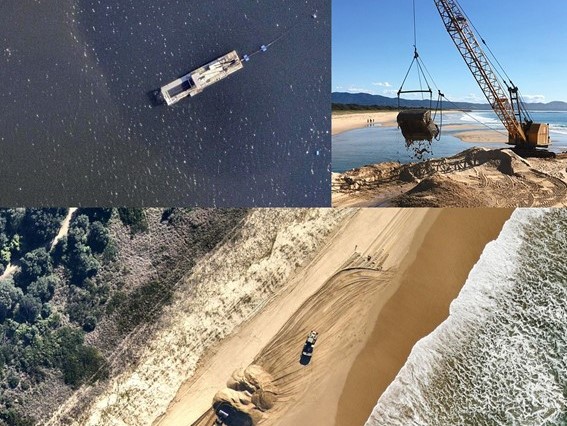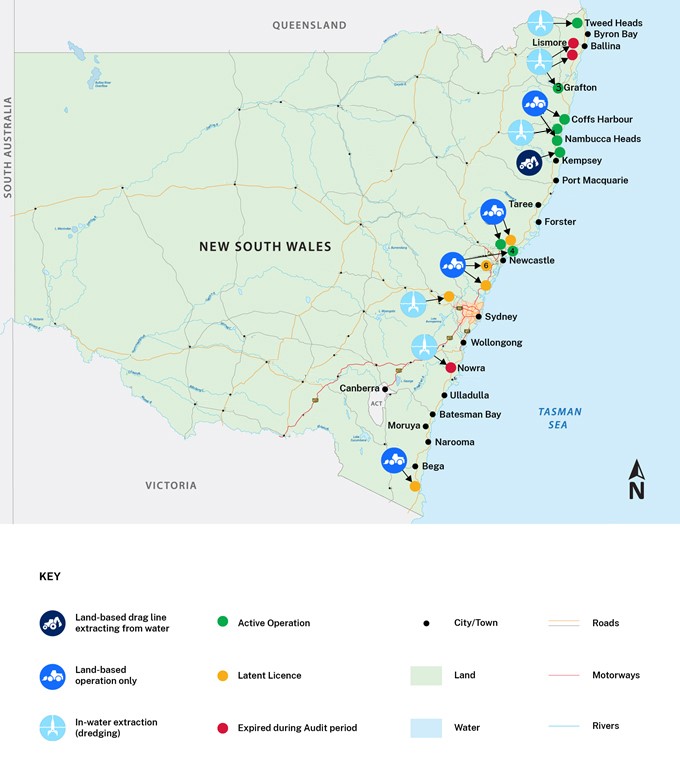Commercial dredging best practice
 A dredge operating in the Shoalhaven estuary, taking sand from a shallow bank and pumping it as a slurry to be processed and stored on shore (NearMaps 2023). Top right: A dragline dredge operating at the entrance to Back Creek at South West Rocks (Malcolm Robertson 2023). Bottom: Loaders extracting sand from Boambee Beach near Coffs Harbour (NearMaps 2023)
A dredge operating in the Shoalhaven estuary, taking sand from a shallow bank and pumping it as a slurry to be processed and stored on shore (NearMaps 2023). Top right: A dragline dredge operating at the entrance to Back Creek at South West Rocks (Malcolm Robertson 2023). Bottom: Loaders extracting sand from Boambee Beach near Coffs Harbour (NearMaps 2023)
Overview
Why is this project important?
The supply of sand and gravel is important to the production of concrete for the construction industry and for other industries such as ceramics, glass and landscaping.
In NSW, this material is extracted from a variety of sources, including from estuaries, dunes and beaches.
Dredging and extraction in estuarine and coastal environments was found to present high to moderate risks to environmental assets in the NSW Marine Estate Threat and Risk Assessment Report (2017).
The potential impacts that must be managed include physical changes to the bed of the estuary, impacts on water quality, changes in water flow patterns, reduced access to fishing grounds, and impacts on seagrass and other estuarine vegetation.
Where dredging and extraction activities occur on Crown land or in Crown waterways, they must usually be licenced under the Crown Land Management Act 2016.
Two projects have been funded under Initiative 2 of the Marine Estate Management Strategy (MEMS), to better understand and manage potential risks to the marine estate from licenced commercial operations.
What are we doing?
The first project was to conduct an audit of commercial dredging and extraction on coastal Crown land.
The second project will focus on implementing high priority actions from the audit to improve the oversight and management of commercial dredging and extraction operations occurring in our estuaries, and on our coastal land and beaches.
This includes reviewing specific operations licenced under the Crown Land Management Act 2016, the close out of latent or unused licences, the development of standardised licence conditions, and developing a more contemporary and coordinated approach towards regulation and compliance.
What have we achieved so far?
In the first phase of this project, an audit was undertaken of all known commercial dredging and extraction operations on coastal Crown land, licenced under the Crown Land Management Act 2016.
The audit also examined how the conditions and approvals under which these licences operate, compared with modern best practice for managing environmental risks.
The audit report included a suite of recommendations for improving the oversight and management of commercial dredging and extraction operations occurring in our estuaries and on our beaches and these have been prioritised for implementation in phase two of the project. The results of the audit are available here. (PDF, 1480.65 KB)
“Access to quality sand and gravel is important for our communities, but when extracting these natural resources from the coastal environment, we need to balance economic benefits against risks to important values such as water quality and productive healthy ecosystems.”
E/Prof Danny Bucher, Project Officer Marine Estate
Locations
Statewide
Local government areas - Statewide
Lead agency
Department of Planning and Environment – Crown Lands (Coastal Unit)
Partners
Most commercial operations require development consent from their local council.
In addition to a Crown Land licence, approvals from other Government agencies, such as the Department of Primary Industries – Fisheries and the Environmental Protection Authority, may be needed.
NSW Department of Climate Change, Energy, the Environment and Water is also a key partner in the implementation of actions to improve the framework for assessing proposals to undertake dredging and extraction in the coastal zone.
While dredging that is purely for port or navigational purposes is not included in this project, some commercial operations do also serve a navigational role or may impact on navigation, so Transport for NSW – Maritime is also a key partner.
Councils, licensees, state agencies and impacted stakeholders, such as commercial fishers, will continue to be widely consulted as part of this project.
More information
Commercial dredging and extraction licences on coastal Crown land in NSW. Numbers in some locations indicate multiple licences.
